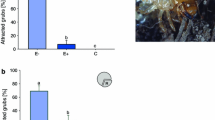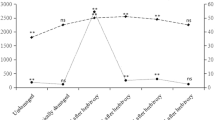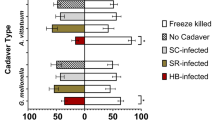Abstract
The milfoil weevil Euhrychiopsis lecontei is a specialist aquatic herbivore that feeds, oviposits, and mates on the invasive freshwater macrophyte Myriophyllum spicatum. We characterized the weevil's preference for M. spicatum, and through bioassay-driven fractionation, isolated and identified two chemicals released by M. spicatum that attract E. lecontei. Mass spectrometry and nuclear magnetic resonance spectroscopy were used to identify the attractive compounds as glycerol and uracil. Dose-response curves for glycerol and uracil indicated that weevil preference increased as sample concentration increased. Weevils were attracted to a crude sample of M. spicatum-released chemicals from 0.17 to 17 mg/l, to glycerol from 18 to 1800 μM (0.0017–0.17 mg/l), and to uracil from 0.015 to 15 μM (0.00014–1.4 mg/l). Although glycerol and uracil are ubiquitous, weevils are likely responding to high concentrations that are released as a result of the rapid growth of M. spicatum. Uracil concentration was greater in the exudates of M.spicatum than other Myriophyllum spp. E. lecontei was attracted to glycerol at a concentration similar to that at which terrestrial insects are attracted to sugar alcohols. This is the first example of a freshwater specialist insect being attracted to chemicals released by its host plant. Analysis of the water milfoil–weevil interaction provides further understanding as to how insects locate their host plants in aquatic systems.




Similar content being viewed by others
References
E. Bartlet M. M. Blight P. Lane I. H. Williams (1997) ArticleTitleThe responses of the cabbage seed weevil Ceutorhynchus assimilis to volatile compounds from oilseed rape in a linear track olfactometer Entomol. Exp. Appl. 85 257–262 Occurrence Handle10.1023/A:1003140219888
E. A. Bernays R. F. Chapman (1994) Host Plant Selection by Phytophagous Insects Chapman & Hall New York
C. W. Boylen L. W. Eichler J. D. Madsen (1999) ArticleTitleLoss of native aquatic plant species in a community dominated by Eurasian watermilfoil Hydrobiologia 415 207–211 Occurrence Handle10.1023/A:1003804612998
E. G. Brown Y. Turan (1995) ArticleTitlePyrimidine metabolism and secondary product formation; biogenesis of albizziine, 4-hydroxyhomoarginine and 2,3-diaminopropanoic acid Phytochemistry 40 763–771 Occurrence Handle10.1016/0031-9422(95)00317-Z Occurrence Handle1:CAS:528:DyaK2MXoslyksLc%3D
T. J. A. Bruce L. J. Wadhams C. M. Woodcock (2005) ArticleTitleInsect host location: a volatile situation Trends Plant Sci. 10 269–274 Occurrence Handle15949760 Occurrence Handle10.1016/j.tplants.2005.04.003 Occurrence Handle1:CAS:528:DC%2BD2MXltVaqsbc%3D
G. R. Buckingham C. A. Bennett (1995) ArticleTitleHost range studies with Bagous affinis (Coleoptera: Curculionidae), an Indian weevil that feeds on hydrilla tubers Environ. Entomol. 27 469–479
W. E. S. Carr (1988) The molecular nature of chemical stimuli in the aquatic environment J. Atema R. R. Fay A. N. Popper W. N. Tavolga (Eds) Sensory Biology of Aquatic Animals Springer-Verlag New York 3–27
T. D. Center F. A. Dray G. Jubinsky M. J. Grodowitz (2002) Insects and Other Arthropods that Feed on Aquatic and Wetland Plants USDA, Agricultural Research Service Fort Lauderdale, FL
R. F. Chapman (2003) ArticleTitleContact chemoreception in feeding by phytophagous insects Annu. Rev. Entomol. 48 455–484 Occurrence Handle12414737 Occurrence Handle10.1146/annurev.ento.48.091801.112629 Occurrence Handle1:CAS:528:DC%2BD3sXnvVyksg%3D%3D
C. Choi C. Bareiss O. Walenciak E. M. Gross (2002) ArticleTitleImpact of polyphenols on growth of the aquatic herbivore Acentria ephemerella J. Chem. Ecol. 28 2245–2256 Occurrence Handle12523565 Occurrence Handle10.1023/A:1021049332410 Occurrence Handle1:CAS:528:DC%2BD38Xos1Knur4%3D
R. P. Creed S. P. Sheldon (1994) ArticleTitleAquatic weevils (Coleoptera, Curculionidae) associated withnorthern watermilfoil (Myriophyllum sibiricum) in Alberta, Canada Entomol. News 105 98–102
R. P. Creed S. P. Sheldon (1995) ArticleTitleWeevils and watermilfoil: Did a North American herbivore cause the decline of an exotic plant? Ecol. Appl. 5 1113–1121
G. Cronin K. D. Wissing D. M. Lodge (1998) ArticleTitleComparative feeding selectivity of herbivorous insects on water lilies: aquatic vs. semi-terrestrial insects and submersed vs. floating leaves Freshw. Biol. 39 243–257 Occurrence Handle10.1046/j.1365-2427.1998.00279.x
G. Cronin D. M. Lodge M. E. Hay M. Miller A. M. Hill T. Horvath R. C. Bolser N. Lindquist M. Wahl (2002) ArticleTitleCrayfish feeding preferences for fresh water macrophytes: The influence of plant structure and chemistry J. Crustac. Biol. 22 708–718
A. W. Decho K. A. Browne R. K. Zimmerfaust (1998) ArticleTitleChemical cues: Why basic peptides are signal molecules in marine environments Limnol. Oceanogr. 43 1410–1417 Occurrence Handle1:CAS:528:DyaK1MXkvVym Occurrence Handle10.4319/lo.1998.43.7.1410
P. J. Eastmond (2004) ArticleTitleGlycerol-insensitive Arabidopsis mutants: Gli1 seedlings lack glycerol kinase, accumulate glycerol and are more resistant to abiotic stress Plant J. 37 617–625 Occurrence Handle14756771 Occurrence Handle10.1111/j.1365-313X.2003.01989.x Occurrence Handle1:CAS:528:DC%2BD2cXisVWhtr8%3D
D. W. Gerber R. U. Byerrum R. W. Gee N. E. Tolbert (1988) ArticleTitleGlycerol concentration in crop plants Plant Sci. 56 31–38 Occurrence Handle10.1016/0168-9452(88)90182-3 Occurrence Handle1:CAS:528:DyaL1cXmtVygsbY%3D
H. Godmaire C. Nalewajko (1990) ArticleTitleStructure and development of secretory trichomes on Myriophyllum spicatum L Aquat. Bot. 37 99–121 Occurrence Handle10.1016/0304-3770(90)90085-Y
E. M. Gross (2003) ArticleTitleDifferential response of tellimagrandin II and total bioactive hydrolysable tannins in an aquatic angiosperm to changes in light and nitrogen Oikos 103 497–504 Occurrence Handle10.1034/j.1600-0706.2003.12666.x Occurrence Handle1:CAS:528:DC%2BD3sXpvFCiurg%3D
E. M. Gross H. Meyer G. Schilling (1996) ArticleTitleRelease and ecological impact of algicidal hydrolysable polyphenols in Myriophyllum spicatum Phytochemistry 41 133–138 Occurrence Handle10.1016/0031-9422(95)00598-6 Occurrence Handle1:CAS:528:DyaK28XisVWqsA%3D%3D
M. E. Hay P. D. Steinberg (1992) The chemical ecology of plant–herbivore interactions in marine versus terrestrial communities G. A. Rosenthal M. R. Berenbaum (Eds) Herbivores: Their Interactions with Secondary Plant Metabolites, 2E Academic Press San Diego, CA 371–413
M. E. Hay J. J. Stachowicz E. Cruz-Rivera S. Bullard M. S. Deal N. Lindquist (1998) Bioassays with marine and freshwater macroorganisms K. F. Haynes J. G. Millar (Eds) Methods in Chemical Ecology, Vol. 2, Bioassay Methods Chapman and Hall New York 39–141
J. Kubanek M. E. Hay P. J. Brown N. Lindquist W. Fenical (2001) ArticleTitleLignoid chemical defenses in the freshwater macrophyte Saururus cernuus Chemoecology 11 1–8 Occurrence Handle1:CAS:528:DC%2BD3MXivVOkurk%3D
E. Leu A. Krieger-Liszkay C. Goussias E. M. Gross (2002) ArticleTitlePolyphenolic allelochemicals from the aquatic angiosperm Myriophyllum spicatum inhibit photosystem II Plant Physiol. 130 2011–2018 Occurrence Handle12481084 Occurrence Handle10.1104/pp.011593 Occurrence Handle1:CAS:528:DC%2BD3sXktlOh
Y. K. Li D. Yu X. Yan (2004) ArticleTitleAre polyphenolics valuable in anti-herbivory strategies of submersed freshwater macrophytes? Arch. Hydrobiol. 161 391–402 Occurrence Handle10.1127/0003-9136/2004/0161-0391 Occurrence Handle1:CAS:528:DC%2BD2MXht1Kkt78%3D
H. Lyr H. Streitberg (1955) ArticleTitleDie Verbreitung von Hydropoten in verschiedenen Verwandtschaftskreisen der Wasserpflanzen Wiss. Z.–Martin-Luther-Univ. Halle-Wittenb., Math.-Nat.Wiss. Reihe 4 471–484
J. D. Madsen C. F. Hartleb C. W. Boylen (1991) ArticleTitlePhotosynthetic characteristics of Myriophyllum spicatum and six submersed aquatic macrophyte species native to Lake George, New York Freshw. Biol. 26 233–240
M. D. Marko F. R. Stermitz (1997) ArticleTitleTransfer of alkaloids from Delphinium to Castilleja via root parasitism. Norditerpenoid alkaloid analysis by electrospray mass spectrometry Biochem. Syst. Ecol. 25 279–285 Occurrence Handle1:CAS:528:DyaK2sXksVGmtLw%3D Occurrence Handle10.1016/S0305-1978(97)00010-0
B. Meijkamp R. Aerts J. Staaij ParticleVan De M. Tosserams W. H. O. Ernst J. Rozema (1999) Effects of UV-B on secondary metabolites in plants J. Rozema (Eds) Stratospheric Ozone Depletion: The Effects of Enhanced UV-B Radiation on Terrestrial Ecosystems Backhuys Publishers Leiden, The Netherlands 71–99
R. L. Metcalf E. R. Metcalf (1992) Chemical Ecology of Plant Kairomones Chapman and Hall New York, NY
M. L. Moody D. H. Les (2002) ArticleTitleEvidence of hybridity in invasive watermilfoil (Myriophyllum) populations Proc. Natl. Acad. Sci. USA 99 14867–14871 Occurrence Handle12407174 Occurrence Handle10.1073/pnas.172391499 Occurrence Handle1:CAS:528:DC%2BD38Xpt1yrt7s%3D
S. Nakai Y. Inoue A. Hosomi A. Murakami (2000) ArticleTitleMyriophyllum spicatum-released allelopathic polyphenols inhibiting growth of blue-green algae Microcystis aeruginosa Water Res. 34 3026–3032 Occurrence Handle10.1016/S0043-1354(00)00039-7 Occurrence Handle1:CAS:528:DC%2BD3cXktFWksL4%3D
C. Nalewajko H. Godmaire (1996) ArticleTitleExtracellular products of Myriophyllum spicatum L. as a function of growth phase and diel cycle Arch. Hydrobiol. 127 345–356
R. M. Newman (2004) ArticleTitleBiological control of Eurasian watermilfoil by aquatic insects: Basic insights from an applied problem Arch. Hydrobiol. 159 145–184 Occurrence Handle10.1127/0003-9136/2004/0159-0145
R. M. Newman M. E. Borman S. W. Castro (1997) ArticleTitleDevelopmental performance of the weevil Euhrychiopsis lecontei on native and exotic watermilfoil host plants J. North Am. Benthol. Soc. 16 627–634
D. M. Oseid J. L. L. Smith (1974) ArticleTitleChronic toxicity of hydrogen sulfide to Gammarus pseudolimnaeus Trans. Am. Fish. Soc. 103 819–822 Occurrence Handle10.1577/1548-8659(1974)103<819:CTOHST>2.0.CO;2 Occurrence Handle1:CAS:528:DyaE2MXhsFShs78%3D
M. L. Ostrofsky E. R. Zettler (1986) ArticleTitleChemical defenses in aquatic plants J. Ecol. 74 279–287 Occurrence Handle1:CAS:528:DyaL28Xit1ajsb8%3D
P. W. Paré J. H. Tumlinson (1999) ArticleTitlePlant volatiles as a defense against insect herbivores Plant Physiol. 121 325–331 Occurrence Handle10517823
C. R. Roseland M. B. Bates R. B. Carlson C. Y. Oseto (1992) ArticleTitleDiscrimination of sunflower volatiles by the red sunflower seed weevil Entomol. Exp. Appl. 62 99–106 Occurrence Handle10.1007/BF00345480 Occurrence Handle1:CAS:528:DyaK38XisFamu78%3D
J. Rozema J. Staaij Particlevan de L. Olof Bjorn N. Bakker Particlede (1999) Depletion of stratospheric ozone and solar UV-B radiation: Evolution of land plants, UV-screens and functions of polyphenolics J. Rozema (Eds) Stratospheric Ozone Depletion: The Effects of Enhanced UV-B Radiation on Terrestrial Ecosystems Backhuys Publishers Leiden, The Netherlands 1–19
J. Ruther T. Meiners J. L. M. Steidle (2002) ArticleTitleRich in phenomena-lacking in terms. A classification of kairomones Chemoecology 12 161–167
S. M. Salom J. A. Carlson B. N. Ang D. M. Grosman E. R. Day (1994) ArticleTitleLaboratory evaluation of biologically-based compounds as antifeedants for the Pales weevil, Hylobius pales (Herbst) (Coleoptera: Curculionidae) J. Entomol. Sci. 29 407–419 Occurrence Handle1:CAS:528:DyaK2cXlslejsb4%3D
A. Schmidt Y. H. Su R. Kunze S. Warner M. Hewitt R. D. Slocum U. Ludewig W. B. Frommer M. Desimone (2004) ArticleTitleUPS1 and UPS2 from Arabidopsis mediate high affinity transport of uracil and 5-fluorouracil J. Biol. Chem. 279 44817–44824 Occurrence Handle15308648 Occurrence Handle1:CAS:528:DC%2BD2cXosFymtbs%3D
S. P. Sheldon R. P. Creed (1995) ArticleTitleUse of a native insect as a biological control for an introduced weed Ecol. Appl. 5 1122–1132
L. E. Smart M. M. Blight A. J. Hick (1997) ArticleTitleEffect of visual cues and a mixture of isothiocyanates on trap capture of cabbage seed weevil, Ceutorhynchus assimilis J. Chem. Ecol. 23 889–902 Occurrence Handle1:CAS:528:DyaK2sXjslCqtbw%3D
C. S. Smith J. W. Barko (1990) ArticleTitleEcology of Eurasian watermilfoil J. Aquat. Plant Manage. 28 55–64
S. L. Solarz R. M. Newman (1996) ArticleTitleOviposition specificity and behavior of the watermilfoil specialist Euhrychiopsis lecontei Oecologia 106 337–344 Occurrence Handle10.1007/BF00334561
S. L. Solarz R. M. Newman (2001) ArticleTitleVariation in hostplant preference and performance by the milfoil weevil, Euhrychiopsis lecontei Dietz, exposed to native and exotic watermilfoils Oecologia 126 66–75 Occurrence Handle10.1007/s004420000484
B. Spänhoff C. Kock A. Meyer E. I. Meyer (2005) ArticleTitleDo grazing caddisfly larvae of Melampophylax mucoreus (Limnephilidae) use their antennae for olfactory food detection? Physiol. Entomol. 30 134–143
D. F. Spencer G. G. Ksander (1999) ArticleTitlePhenolic acids and nutrient content for aquatic macrophytes from Fall River, California J. Freshw. Ecol. 14 197–209 Occurrence Handle1:CAS:528:DyaK1MXjvV2ns7k%3D
K. G. Wagner A. I. Backer (1992) ArticleTitleDynamics of nucleotides in plants studied on a cellular basis Int. Rev. Cyt. 134 1–84 Occurrence Handle1:CAS:528:DyaK38XmsVymsrc%3D
O. Walenciak W. Zwisler E. M. Gross (2002) ArticleTitleInfluence of Myriophyllum spicatum-derived tannins on gut microbiota of its herbivore Acentria ephemerella J. Chem. Ecol. 28 2045–2056 Occurrence Handle12474899 Occurrence Handle10.1023/A:1020754012785 Occurrence Handle1:CAS:528:DC%2BD38XnvFOiur0%3D
P. G. Waterman (1998) Chemical taxonomy of alkaloids M. F. Roberts M. Wink (Eds) Alkaloids: Biochemistry, Ecology, and Medicinal Applications Plenum Press New York 87–106
A. R. Weig C. Jakob (2000) ArticleTitleFunctional identification of the glycerol permease activity of Arabidopsis thaliana NLM1 and NLM2 proteins by heterologous expression in Saccharomyces cerevisiae FEBS Lett. 281 293–298
M. J. Weissburg M. C. Ferner D. P. Pisut D. L. Smee (2002) ArticleTitleEcological consequences of chemically mediated prey perception J. Chem. Ecol. 28 1953–1970 Occurrence Handle12474893 Occurrence Handle10.1023/A:1020741710060 Occurrence Handle1:CAS:528:DC%2BD38XnvFOitbk%3D
Acknowledgments
We thank Elisabeth M. Gross for the gift of tellimagrandin II and Frank R. Stermitz for analysis of alkaloid content. We are grateful to Tom Krick, Letitia Yao, Beverly Ostrowski, and LeeAnn Higgins for assistance and advice with the mass spectral and NMR analyses. We thank M. Moody for molecular identification of Myriophyllum spp. Assistance with specimen collection and analyses were provided by D. Ward, C. Lemmon, S. Daugherty, S. Coloso, J. Dehn, K. Eichstaedt, C. McCollum, and K. Mann. We thank LeeAnn Higgins and two anonymous reviewers for their comments on the manuscript. This work is sponsored by the Minnesota Sea Grant College Program supported by the NOAA Office of Sea Grant, United States Department of Commerce, under grant no. NOAA-NA16-RG1046. The U.S. government is authorized to reproduce and distribute reprints for government purposes, not withstanding any copyright notation that may appear hereon. Additional support was provided by the Minnesota Agricultural Experiment Station and the University of Minnesota Graduate School. This paper is journal reprint no. JR 511 of the Minnesota Sea Grant College Program.
Author information
Authors and Affiliations
Corresponding author
Rights and permissions
About this article
Cite this article
Marko, M.D., Newman, R.M. & Gleason, F.K. Chemically Mediated Host-Plant Selection by the Milfoil Weevil: A Freshwater Insect–Plant Interaction. J Chem Ecol 31, 2857–2876 (2005). https://doi.org/10.1007/s10886-005-8399-7
Received:
Revised:
Accepted:
Published:
Issue Date:
DOI: https://doi.org/10.1007/s10886-005-8399-7




